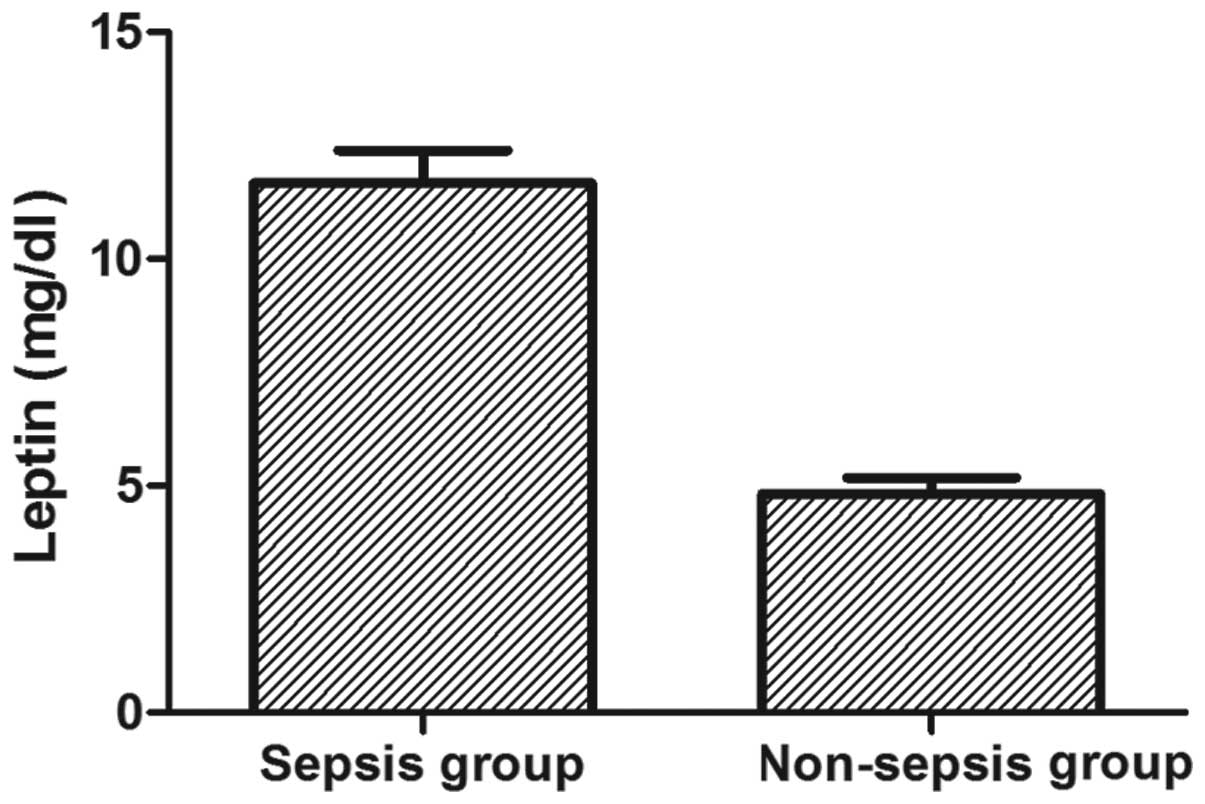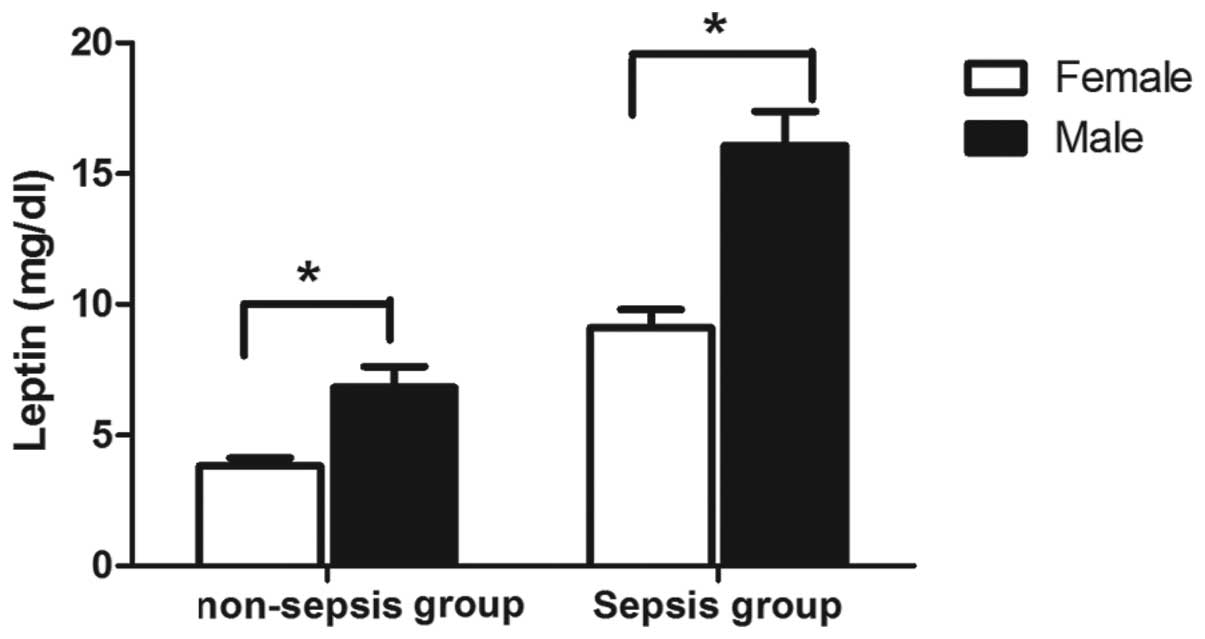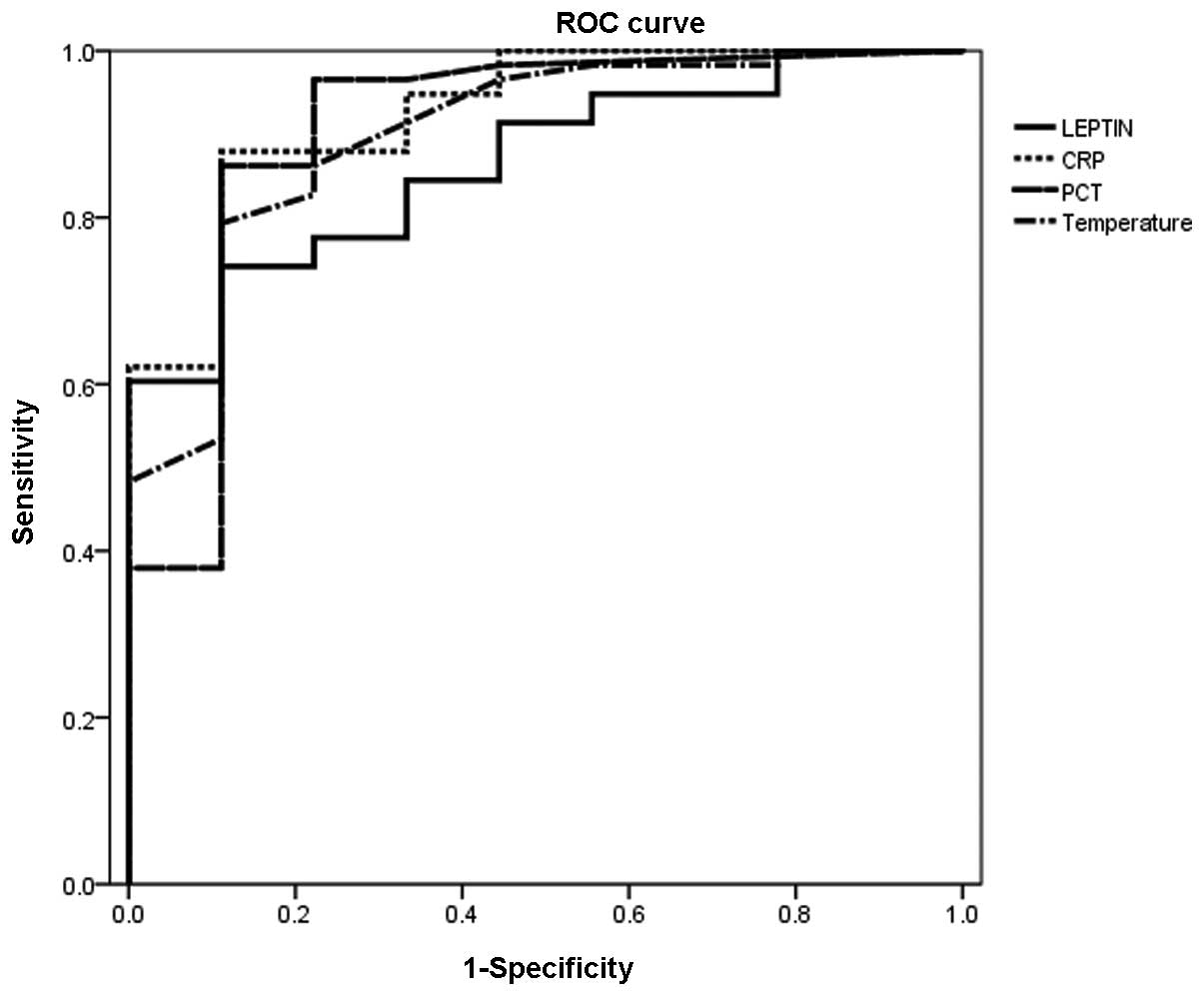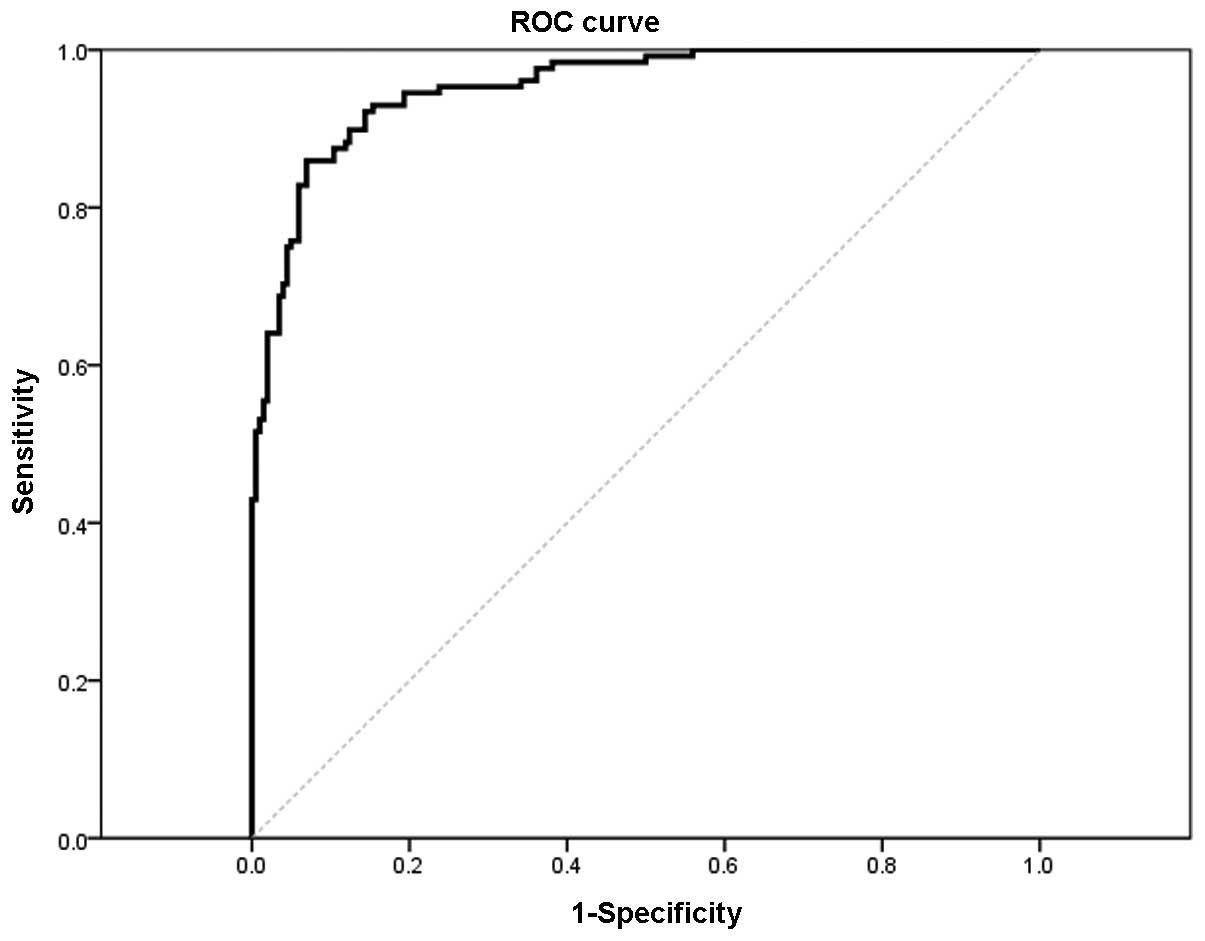|
1
|
Monneret G: Immunology programs must
include sepsis. Science. 328:11062010. View Article : Google Scholar : PubMed/NCBI
|
|
2
|
Cohen J: The immunopathogenesis of sepsis.
Nature. 420:885–891. 2002. View Article : Google Scholar : PubMed/NCBI
|
|
3
|
Arabi Y, Al Shirawi N, Memish Z, Venkatesh
S and Al-Shimemeri A: Assessment of six mortality prediction models
in patients admitted with severe sepsis and septic shock to the
intensive care unit: a prospective cohort study. Crit Care.
7:R116–R122. 2003.PubMed/NCBI
|
|
4
|
Banta JE, Joshi KP, Beeson L and Nguyen
HB: Patient and hospital characteristics associated with inpatient
severe sepsis mortality in California, 2005–2010. Crit Care Med.
40:2960–2966. 2012.PubMed/NCBI
|
|
5
|
Blanco Quirós A, Casado Flores J, Nieto
Moro M, Garrote Adrados JA, Arranz Sanz E and Asensio Antón J:
Meningococcal sepsis in pediatrics. Parameters associated with poor
outcome. An Pediatr (Barc). 61:305–313. 2004.(In Spanish).
|
|
6
|
Hotchkiss RS and Opal S: Immunotherapy for
sepsis - a new approach against an ancient foe. N Engl J Med.
363:87–89. 2010. View Article : Google Scholar : PubMed/NCBI
|
|
7
|
Cohen-Wolkowiez M, Benjamin DK Jr and
Capparelli E: Immunotherapy in neonatal sepsis: advances in
treatment and prophylaxis. Curr Opin Pediatr. 21:177–181. 2009.
View Article : Google Scholar : PubMed/NCBI
|
|
8
|
O’Callaghan A and Redmond HP: Treatment of
sepsis: current status of clinical immunotherapy. Surgeon.
4:355–361. 2006.
|
|
9
|
Martin GS: Sepsis, severe sepsis and
septic shock: changes in incidence, pathogens and outcomes. Expert
Rev Anti Infect Ther. 10:701–706. 2012. View Article : Google Scholar : PubMed/NCBI
|
|
10
|
Fried E, Weissman C and Sprung C:
Postoperative sepsis. Curr Opin Crit Care. 17:396–401. 2011.
View Article : Google Scholar
|
|
11
|
Müller B, Becker KL, Schächinger H, et al:
Calcitonin precursors are reliable markers of sepsis in a medical
intensive care unit. Crit Care Med. 28:977–983. 2000.PubMed/NCBI
|
|
12
|
Andaluz-Ojeda D, Bobillo F, Iglesias V, et
al: A combined score of pro- and anti-inflammatory interleukins
improves mortality prediction in severe sepsis. Cytokine.
57:332–336. 2012. View Article : Google Scholar : PubMed/NCBI
|
|
13
|
Song R, Kim J, Yu D, Park C and Park J:
Kinetics of IL-6 and TNF-α changes in a canine model of sepsis
induced by endotoxin. Vet Immunol Immunopathol. 146:143–149.
2012.
|
|
14
|
Abdel-Hafez NM, Saleh Hassan Y and
El-Metwally TH: A study on biomarkers, cytokines, and growth
factors in children with burn injuries. Ann Burns Fire Disasters.
20:89–100. 2007.PubMed/NCBI
|
|
15
|
Hoda MR, Theil G, Mohammed N, Fischer K
and Fornara P: The adipocyte-derived hormone leptin has
proliferative actions on androgen-resistant prostate cancer cells
linking obesity to advanced stages of prostate cancer. J Oncol.
2012:2803862012.
|
|
16
|
Miyazaki S, Izawa T, Ogasawara JE, et al:
Effect of exercise training on adipocyte-size-dependent expression
of leptin and adiponectin. Life Sci. 86:691–698. 2010. View Article : Google Scholar : PubMed/NCBI
|
|
17
|
Bates SH, Stearns WH, Dundon TA, et al:
STAT3 signalling is required for leptin regulation of energy
balance but not reproduction. Nature. 421:856–859. 2003. View Article : Google Scholar : PubMed/NCBI
|
|
18
|
Behnes M, Brueckmann M, Lang S, et al:
Alterations of leptin in the course of inflammation and severe
sepsis. BMC Infect Dis. 12:2172012. View Article : Google Scholar : PubMed/NCBI
|
|
19
|
Mackey-Lawrence NM and Petri WA Jr: Leptin
and mucosal immunity. Mucosal Immunol. 5:472–479. 2012.PubMed/NCBI
|
|
20
|
Conde J, Scotece M, Gómez R, Gómez-Reino
JJ, Lago F and Gualillo O: At the crossroad between immunity and
metabolism: focus on leptin. Expert Rev Clin Immunol. 6:801–808.
2010. View Article : Google Scholar : PubMed/NCBI
|
|
21
|
De Rosa V, Procaccini C, Cali G, et al: A
key role of leptin in the control of regulatory T cell
proliferation. Immunity. 26:241–255. 2007.PubMed/NCBI
|
|
22
|
Hasenkrug KJ: The leptin connection:
regulatory T cells and autoimmunity. Immunity. 26:143–145. 2007.
View Article : Google Scholar : PubMed/NCBI
|
|
23
|
Bone RC, Balk RA, Cerra FB, et al:
Definitions for sepsis and organ failure and guidelines for the use
of innovative therapies in sepsis. The ACCP/SCCM Consensus
Conference Committee American College of Chest Physicians/Society
of Critical Care Medicine. Chest. 101:1644–1655. 1992. View Article : Google Scholar
|
|
24
|
Zhang J, She D, Feng D, Jia Y and Xie L:
Dynamic changes of serum soluble triggering receptor expressed on
myeloid cells-1 (sTREM-1) reflect sepsis severity and can predict
prognosis: a prospective study. BMC Infect Dis. 11:532011.
View Article : Google Scholar
|
|
25
|
Arnalich F, López J, Codoceo R, Jim nez M,
Madero R and Montiel C: Relationship of plasma leptin to plasma
cytokines and human survivalin sepsis and septic shock. J Infect
Dis. 180:908–911. 1999. View
Article : Google Scholar : PubMed/NCBI
|
|
26
|
Dellinger RP, Levy MM, Rhodes A, et al:
Surviving sepsis campaign: international guidelines for management
of severe sepsis and septic shock: 2012. Crit Care Med. 41:580–637.
2013. View Article : Google Scholar
|
|
27
|
Su L, Han B, Liu C, et al: Value of
soluble TREM-1, procalcitonin, and C-reactive protein serum levels
as biomarkers for detecting bacteremia among sepsis patients with
new fever in intensive care units: a prospective cohort study. BMC
Infect Dis. 12:1572012. View Article : Google Scholar
|
|
28
|
Bele N, Darmon M, Coquet I, et al:
Diagnostic accuracy of procalcitonin in critically ill
immunocompromised patients. BMC Infect Dis. 11:2242011. View Article : Google Scholar : PubMed/NCBI
|
|
29
|
Fu Y, Chen J, Cai B, et al: The use of
PCT, CRP, IL-6 and SAA in critically ill patients for an early
distinction between candidemia and Gram positive/negative
bacteremia. J Infect. 64:438–440. 2012. View Article : Google Scholar : PubMed/NCBI
|
|
30
|
Abdollahi A, Shoar S, Nayyeri F and
Shariat M: Diagnostic value of simultaneous measurement of
procalcitonin, interleukin-6 and hs-CRP in prediction of
early-onset neonatal sepsis. Mediterr J Hematol Infect Dis.
4:e20120282012. View Article : Google Scholar : PubMed/NCBI
|
|
31
|
Tsangaris I, Plachouras D, Kavatha D, et
al: Diagnostic and prognostic value of procalcitonin among febrile
critically ill patients with prolonged ICU stay. BMC Infect Dis.
9:2132009. View Article : Google Scholar : PubMed/NCBI
|
|
32
|
Póvoa P, Coelho L, Almeida E, et al: Early
identification of intensive care unit-acquired infections with
daily monitoring of C-reactive protein: a prospective observational
study. Crit Care. 10:R632006.PubMed/NCBI
|
|
33
|
Noor MK, Shahidullah M, Mutanabbi M, Barua
C, Mannan MA and Afroza S: Comparison between CRP and IL-6 as early
markers of neonatal sepsis. Mymensingh Med J. 17(Suppl 2): S72–S76.
2008.PubMed/NCBI
|
|
34
|
Chachkhiani I, Gürlich R, Maruna P, et al:
The postoperative stress response and its reflection in cytokine
network and leptin plasma levels. Physiol Res. 54:279–285.
2005.PubMed/NCBI
|
|
35
|
Cesur S, Irmak H, Eras Z, et al:
Prognostic value of serum TNF-alpha, IL-10, leptin and CRP levels
in newborns with septicemia. Mikrobiyol Bul. 43:607–612. 2009.(In
Turkish).
|
|
36
|
Maruna P, Gürlich R, Frasko R and Haluzík
M: Serum leptin levels in septic men correlate well with C-reactive
protein (CRP) and TNF-alpha but not with BMI. Physiol Res.
50:589–594. 2001.PubMed/NCBI
|
|
37
|
Bracho-Riquelme RL and Reyes-Romero MA:
Leptin in sepsis: a well-suited biomarker in critically ill
patients? Crit Care. 14:1382010. View
Article : Google Scholar : PubMed/NCBI
|














